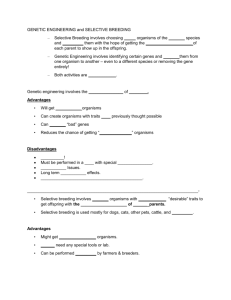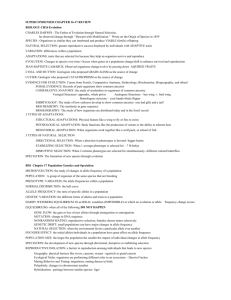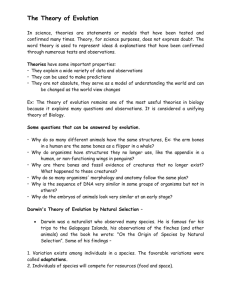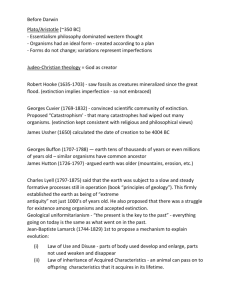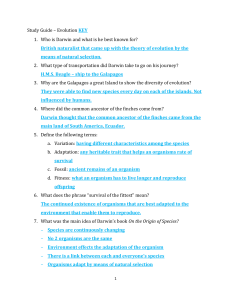Evolution Test Review: High School Biology
advertisement
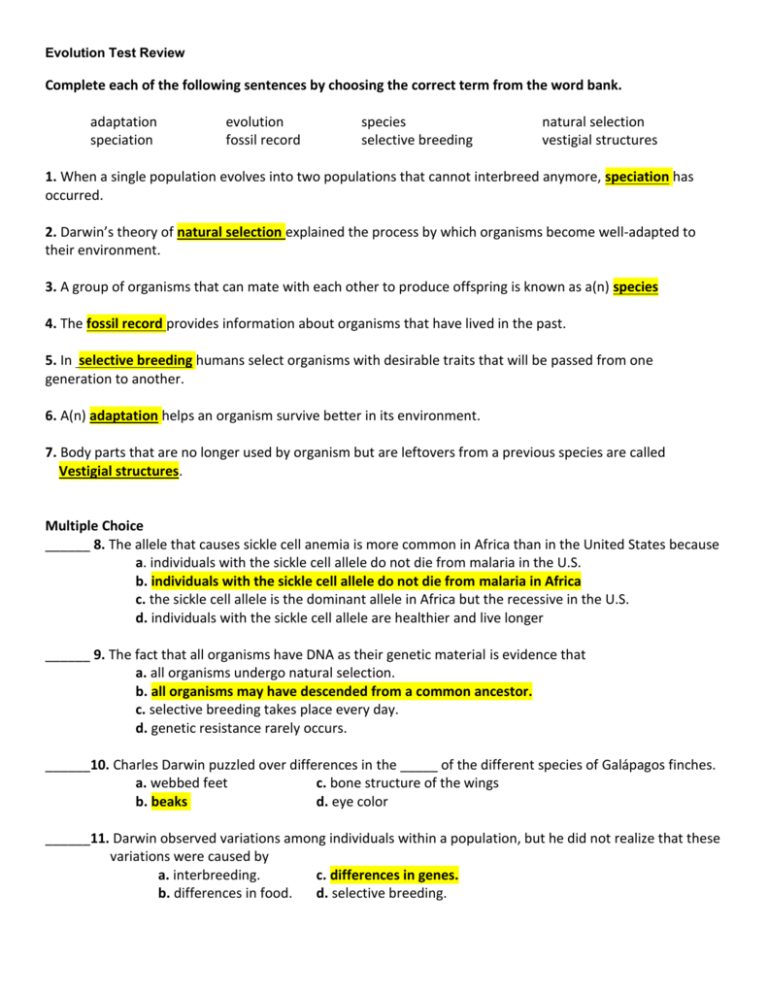
Evolution Test Review Complete each of the following sentences by choosing the correct term from the word bank. adaptation speciation evolution fossil record species selective breeding natural selection vestigial structures 1. When a single population evolves into two populations that cannot interbreed anymore, speciation has occurred. 2. Darwin’s theory of natural selection explained the process by which organisms become well-adapted to their environment. 3. A group of organisms that can mate with each other to produce offspring is known as a(n) species 4. The fossil record provides information about organisms that have lived in the past. 5. In selective breeding humans select organisms with desirable traits that will be passed from one generation to another. 6. A(n) adaptation helps an organism survive better in its environment. 7. Body parts that are no longer used by organism but are leftovers from a previous species are called Vestigial structures. Multiple Choice ______ 8. The allele that causes sickle cell anemia is more common in Africa than in the United States because a. individuals with the sickle cell allele do not die from malaria in the U.S. b. individuals with the sickle cell allele do not die from malaria in Africa c. the sickle cell allele is the dominant allele in Africa but the recessive in the U.S. d. individuals with the sickle cell allele are healthier and live longer ______ 9. The fact that all organisms have DNA as their genetic material is evidence that a. all organisms undergo natural selection. b. all organisms may have descended from a common ancestor. c. selective breeding takes place every day. d. genetic resistance rarely occurs. ______10. Charles Darwin puzzled over differences in the _____ of the different species of Galápagos finches. a. webbed feet c. bone structure of the wings b. beaks d. eye color ______11. Darwin observed variations among individuals within a population, but he did not realize that these variations were caused by a. interbreeding. c. differences in genes. b. differences in food. d. selective breeding. True or False: 12. Darwin’s theory of natural selection provides the correct mechanism for evolution. _____T______ 13. Individuals can decide to change their traits in order to adapt to the environment. ___ F_____ 14. Mutations occur randomly and always have a negative effect on the organism. ___ F_____ 15. When Darwin left on his voyage, most scientists believed that organisms change through time. ____ 16. Whether or not an organism is the best suited (most “fit”) depends on the environment it is in. ___ F __ T ____ Short Answer 17. Identify two ways that organisms can be compared to provide evidence of evolution from a common ancestor. Comparative Anatomy (see evidence of evolution notes) Comparative Embryology (see evidence of evolution notes) Comparative Genetics (see evidence of evolution notes) 18. Describe evidence that supports the hypothesis that whales evolved from land-dwelling mammals. See page 112 in textbook Although modern whales do not have hind limbs, inside their bodies are tiny hip bones. Scientist think that these hip bones were inherited from the whlaes’ four-legged ancestors. 19. Explain why a mule is called a hybrid and not considered a separate species. A mule is sterile (will not be able to produce offspring) 20. Explain how genetics is related to evolution. Genetics is the study of the passing of genetic traits from parent to offspring. It provides in great detail how mutations occur and how (during mating) such traits can be passed from one generation to the next. 21. Outline an example of the process of speciation. Step 1: Separation- South American finches were blown out to sea by a storm and began to colonize the Galapagos Islands Step 2: Adaptation- As the finches numbers increased on each islands, the finches began to leave and inhabit new islands. At different islands, different food sources were available so different size and shape beaks were favored. Certain birds began adapting to the each islands food source Step 3: Divergence- Speciation occurs and some finches can no longer interbreed.

